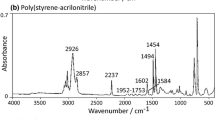Abstract
The influence of α-methyl substitutions on the interpolymer complexation between polyisopropylacrylamides (poly(N-isopropylacrylamide) and poly(N-isopropylmethacrylamide)) and polyacrylic acids (poly(acrylic acid) and poly(methacrylic acid)) has been studied. The influence of solvents on the complexation process and, therefore, the effect of polymer–solvent interactions on the complex formation have been analyzed. Specific interactions were analyzed by Fourier transform infrared spectroscopy, and the composition of the obtained complexes was determined by elemental analysis. Finally, the thermal behavior of the obtained interpolymer complexes has been studied by calorimetry and thermogravimetry.








Similar content being viewed by others
References
Tsuchida E, Abe K (1982) Interactions between macromolecules in solution and intermacromolecular complexes. In: Tsuchida E, Abe K (eds) Interact. Between Macromol. Solut. Intermacromolecular Complexes SE - 1. Springer Berlin Heidelberg, pp 1–119. doi: 10.1007/BFb0017549
Bikerman JJ (1978) Interpolymer complexes, E. A. Bekturov and L. A. Bimendina. Nauka Alma-Ata, 1977, 264pp., Rub. 2.80 [Russian]. J Polym Sci Polym Lett Ed 16:374–375. doi: 10.1002/pol.1978.130160712
Steinschulte A, Schulte B, Erberich M et al (2012) Unimolecular janus micelles by microenvironment-induced, internal complexation. ACS Macro Lett 1:504–507. doi:10.1021/mz300043s
Ruiz-Rubio L, Marin JR, Patrocinio D et al (2013) Associative and segregative phase behaviour in mixtures of poly(N-tert-butylacrylamide) and poly(N, N-diethylacrylamide) with poly(4-vinylphenol): effect of solvent and concentration. Colloid Polym Sci 291:2495–2502. doi:10.1007/s00396-013-2988-8
Sukhishvili SA, Kharlampieva E, Izumrudov V (2006) Where polyelectrolyte multilayers and polyelectrolyte complexes meet. Macromolecules 39:8873–8881. doi:10.1021/ma061617p
Kharlampieva E, Sukhishvili SA (2006) Hydrogen bonded layer-by-layer polymer films. J Macromol Sci Polym Rev 46:377–395. doi:10.1080/15583720600945386
Ruiz L, Garay MT, Laza JM et al (2013) Reversible functionalization of nanostructured polymer surfaces via stimuli-responsive interpolymer complexes. Eur Polym J 49:130–138. doi:10.1016/j.eurpolymj.2012.09.010
Taylan B, Gtiven O, Kes S, Hincal AA (1996) Design and evaluation of sustained-release and buccal adhesive propranolol hydrochloride tablets. J Control Release 38:11–20. doi:10.1016/0168-3659(95)00094-1
Lele BS, Hoffman AS (2000) Mucoadhesive drug carriers based on complexes of poly(acrylic acid) and PEGylated drugs having hydrolysable PEG-anhydride-drug linkages. J Control Release 69:237–48. doi:10.1016/S0168-3659(00)00303-5
Erel I, Zhu Z, Zhuk A, Sukhishvili SA (2011) Hydrogen-bonded layer-by-layer films of block copolymer micelles with pH-responsive cores. J Colloid Interface Sci 355:61–9. doi:10.1016/j.jcis.2010.11.083
Hammond PT (2012) Building biomedical materials layer-by-layer. Mater Today 15:196–206. doi:10.1016/S1369-7021(12)70090-1
Vorobieva E, Basalyga I, Krutko N (2003) Colloid-chemical properties of polymeric complexes based on polycarboxylic acids and polyacrylamide. Mater Res Innov 7:322–325. doi:10.1007/s10019-003-0271-1
Garay MT, Ruiz L, Marín JR et al (2010) Associative and segregative phase separations of poly(N-tert-butylacrylamide)/poly(acrylic acid) mixtures. Effect of solvent. Colloid Polym Sci 288:1593–1599. doi:10.1007/s00396-010-2301-z
Ohno H, Nii A, Tsuchida E (1980) Solvent effect on the complex formation of poly(methacrylic acid) with proton-accepting polymers. Die Makromol Chemie 181:1227–1235. doi:10.1002/macp.1980.021810607
Koussathana M, Lianos P, Staikos G (1997) Investigation of hydrophobic interactions in dilute aqueous solutions of hydrogen-bonding interpolymer complexes by steady-state and time-resolved fluorescence measurements. Macromolecules 30:7798–7802. doi:10.1021/ma9706485
Nurkeeva ZS, Mun GA, Khutoryanskiy VV, Sergaziyev AD (2002) Complex formation of polyvinyl ether of diethylene glycol with polyacrylic acid II. Effect of molecular weight of polyacrylic acid and solvent nature. Eur Polym J 38:313–316. doi:10.1016/S0014-3057(01)00188-4
Mun GA, Nurkeeva ZS, Khutoryanskiy VV, Bitekenova AB (2000) Effect of copolymer composition on interpolymer complex formation of (co)poly(vinyl ether)s with poly(acrylic acid) in aqueous and organic solutions. Macromol Rapid Commun 21:381–384. doi:10.1002/(SICI)1521-3927(20000401)21:7<381::AID-MARC381>3.0.CO;2-B
Ruiz-Rubio L, Vilas JL, Rodríguez M, León LM (2014) Thermal behaviour of H-bonded interpolymer complexes based on polymers with acrylamide or lactame groups and poly(acrylic acid): influence of N-alkyl and á-methyl substitutions. Polym Degrad Stab 109:147–153. doi:10.1016/j.polymdegradstab.2014.07.012
Ruiz-Rubio L, Laza JM, Pérez L et al (2013) Polymer–polymer complexes of poly(N-isopropylacrylamide) and poly(N, N-diethylacrylamide) with poly(carboxylic acids): a comparative study. Colloid Polym Sci 292:423–430. doi:10.1007/s00396-013-3086-7
Zhunuspayev DE, Mun GA, Hole P, Khutoryanskiy VV (2008) Solvent effects on the formation of nanoparticles and multilayered coatings based on hydrogen-bonded interpolymer complexes of poly(acrylic acid) with homo- and copolymers of N-vinyl pyrrolidone. Langmuir 24:13742–13747. doi:10.1021/la802852h
Garay MT, Alava C, Rodriguez M (2000) Study of polymer–polymer complexes and blends of poly (N-isopropylacrylamide) with poly (carboxylic acid). 2. Poly (acrylic acid) and poly (methacrylic acid) partially neutralized. Polymer 41:5799–5807. doi:10.1016/S0032-3861(99)00765-X
Brandrup J, Immergut EH, Abe A (2003) Polymer handbook, 4th edn. Wiley, New York
Acknowledgments
The authors thank the Basque Country Government for the financial support (Ayudas para apoyar las actividades de los grupos de investigación del sistema universitario vasco, IT718-13). Technical and human support provided by SGIKER (UPV/EHU, MICINN, GV/EJ, ERDF, and ESF) is gratefully acknowledged.
Author information
Authors and Affiliations
Corresponding author
Electronic supplementary material
Below is the link to the electronic supplementary material.
ESM 1
(PDF 129 kb)
Rights and permissions
About this article
Cite this article
Ruiz-Rubio, L., Álvarez, V., Lizundia, E. et al. Influence of α-methyl substitutions on interpolymer complexes formation between poly(meth)acrylic acids and poly(N-isopropyl(meth)acrylamide)s. Colloid Polym Sci 293, 1447–1455 (2015). https://doi.org/10.1007/s00396-015-3529-4
Received:
Revised:
Accepted:
Published:
Issue Date:
DOI: https://doi.org/10.1007/s00396-015-3529-4




